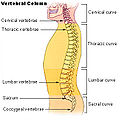- Sacrum
-
For other uses, see Sacrum (disambiguation).
Bone: Sacrum Sacrum, pelvic surface Image of pelvis. Sacrum is in center. Latin os sacrum Gray's subject #24 106 MeSH Sacrum In vertebrate anatomy the sacrum (plural: sacrums or sacra) is a large, triangular bone at the base of the spine and at the upper and back part of the pelvic cavity, where it is inserted like a wedge between the two hip bones. Its upper part connects with the last lumbar vertebra, and bottom part with the coccyx (tailbone). It consists of usually five initially unfused vertebrae which begin to fuse between ages 16–18 and are usually completely fused into a single bone by age 26.
It is curved upon itself and placed obliquely (that is, tilted forward). It is kyphotic — that is, concave facing forwards. The base projects forward as the sacral promontory internally, and articulates with the last lumbar vertebra to form the prominent sacrovertebral angle. The central part is curved outward towards the posterior, allowing greater room for the pelvic cavity.
Contents
Etymology
The name is derived from the Latin (os) sacrum, (sacer, sacra, sacrum, "sacred"), a translation of the Greek hieron (osteon), meaning sacred or strong bone.[1] Since the sacrum is the seat of the organs of procreation, animal sacrums were offered in sacrifices. In Slavic languages and in German this bone is called the "cross bone".[2]
Parts
- The pelvic surface of the sacrum is concave from above downward, and slightly so from side to side.
- The dorsal surface of the sacrum is convex and narrower than the pelvic.
- The lateral surface of the sacrum is broad above, but narrowed into a thin edge below.
- The base of the sacrum, which is broad and expanded, is directed upward and forward.
- The apex (apex oss. sacri) is directed downward, and presents an oval facet for articulation with the coccyx.
- The vertebral canal (canalis sacralis; sacral canal) runs throughout the greater part of the bone; above, it is triangular in form; below, its posterior wall is incomplete, from the non-development of the laminae and spinous processes. It lodges the sacral nerves, and its walls are perforated by the anterior and posterior sacral foramina through which these nerves pass out.
Articulations
The sacrum articulates with four bones:
- the last lumbar vertebra above
- the coccyx (tailbone) below
- the illium portion of the hip bone on either side
Rotation of the sacrum forward a few degrees vis-à-vis the ilia is sometimes called "nutation" (L. "nodding"), and the reverse motion "counter-nutation."[3]
It is called the sacrum when referred to all of the parts combined, but sacral vertebrae when referred individually.
Sexual dimorphism
The sacrum is noticeably sexually dimorphic (differently-shaped in males and females).
In the female the sacrum is shorter and wider than in the male; the lower half forms a greater angle with the upper; the upper half is nearly straight, the lower half presenting the greatest amount of curvature. The bone is also directed more obliquely backward; this increases the size of the pelvic cavity and renders the sacrovertebral angle more prominent.
In the male the curvature is more evenly distributed over the whole length of the bone, and is altogether more massive than in the female.
Variations
In some cases the sacrum will consist of six pieces [1] or be reduced in number to four [2]. The bodies of the first and second vertebrae may fail to unite.
Sometimes the uppermost transverse tubercles are not joined to the rest of the ala on one or both sides, or the sacral canal may be open throughout a considerable part of its length, in consequence of the imperfect development of the laminae and spinous processes.
The sacrum also varies considerably with respect to its degree of curvature.
Additional images
See also
- Bone terminology
- Terms for anatomical location
- Pelvimetry
- Rump (croup)
- Coccyx (tailbone)
- Ileum bone
- Lumbarization
References
External links
- SUNY Labs 43:os-0401 - "The Female Pelvis: Articulated bones of pelvis"
- SUNY Labs 43:st-0401 - "The Female Pelvis: Bones"
- sacrum at eMedicine Dictionary
This article was originally based on an entry from a public domain edition of Gray's Anatomy. As such, some of the information contained within it may be outdated.Nerves: spinal nerves (TA A14.2, GA 9.916) Cervical (8) Thoracic (12) T1, T2, T3, T4, T5, T6, T7, T8, T9, T10, T11, T12
anterior (Intercostal, Intercostobrachial – T2, Thoraco-abdominal nerves – T7–T11, Subcostal – T12) – posterior (Posterior branches of thoracic nerves)Lumbar (5)
anterior (Lumbar plexus, Lumbosacral trunk) · posterior (Posterior branches of the lumbar nerves, Superior cluneal L1–L3)Sacral (5) Coccygeal (1) Bones of torso (TA A02.2,3, GA 2.96–128) Vertebra General structuresbody of vertebra, vertebral arch (pedicle, lamina, vertebral notch), foramina (vertebral, intervertebral), processes (transverse, articular/zygapophysis, spinous), spinal canalUncinate process of vertebra · Transverse foramen · Anterior tubercle · Carotid tubercle · Posterior tubercle
C1 (lateral mass, anterior arch, posterior arch), C2 (dens), C3, C4, C5, C6, C7SacrumThoracic skeleton specific ribs (1, 2, 9, 10, 11, 12, true – 1–7, false – 8–12, floating – 11–12) · parts (Angle, Tubercle, Costal groove, Neck, Head)SternumThoracic cageSuperior thoracic aperture · Inferior thoracic aperture · Intercostal space · Costal margin · Infrasternal angleCategories:- Bones of the torso
- Irregular bones
- Vertebral column
Wikimedia Foundation. 2010.















